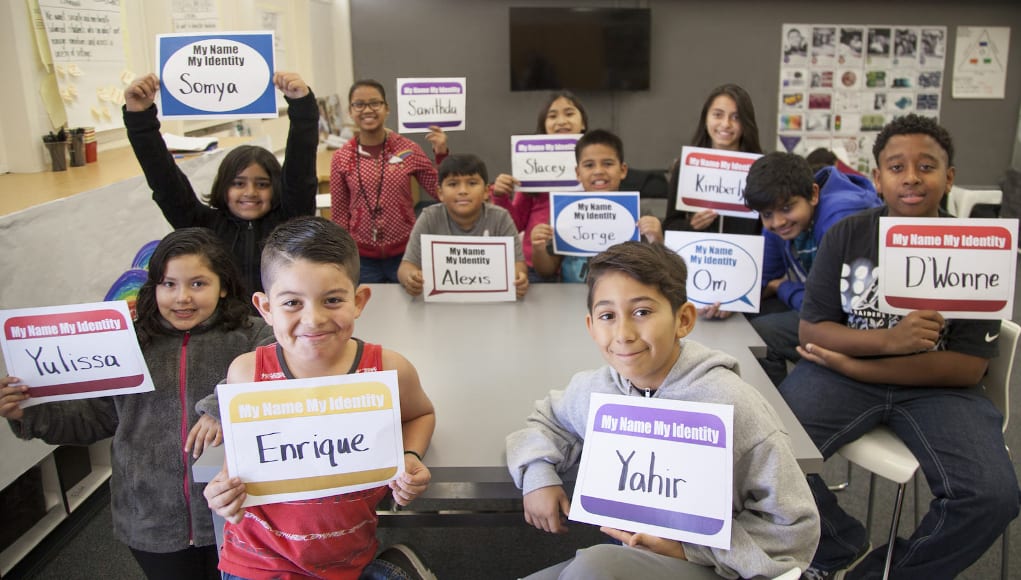Building Global Awareness Through Student Names

By Dr. Yee Wan
In today’s 21st-century global economy, our future graduates will likely have a job that requires them to communicate effectively with people from around the world. As students learn about the stories behind their peers’ names, they are also developing global awareness and respect for others who come from different ethnic, cultural and language backgrounds. These competencies are essential in preparing our future leaders to thrive in an increasingly interdependent world.
My Name, My Identity is a national initiative intended to help create a culture of respect in school communities across the nation by bringing awareness to the proper pronunciation of students’ names. This initiative opens doors for students and teachers to learn about each other’s names and the stories behind them.
The initiative is a joint effort between the Santa Clara County Office of Education (SCCOE) and the National Association for Bilingual Education (NABE), and is based on the belief that pronouncing students’ names correctly sends a strong message that the school community values and embraces the rich language and cultural diversity that students bring to our schools. This can foster a sense of belonging and build positive relationships in the classroom, which are crucial for healthy social, psychological and educational outcomes.

During recent conversations about names and identities with educators and students, I gained a much deeper insight into the profound impact of names on students and adults. The stories I heard affirmed that understanding others’ names can develop empathy, appreciation for language and cultural diversity and build an inclusive school culture that fosters respect and acceptance.

For many students who come from immigrant families, their names are strongly connected to their cultures, family history or aspirations of their parents. Valuing their names and cultures is ever more important in connecting with students at emotional, social and psychological levels.

Another middle school student stated, ‘My first name, Anthony, is named after my dad, and my middle name, James, is my grandfather’s first name. I am proud to have the names of my father and grandfather.’
Here are two short videos showing additional examples of students from DCP El Primero High School and Washoe County School District sharing their name stories:
“I think it is very important to pronounce people’s names correctly, especially immigrant students in particular because they are already feeling a little disconnected …Growing up as an immigrant, I was always worried that someone was going to mispronounce my name” explains Manny Barbara, former superintendent and Vice President, Advocacy and Thought Leadership, Silicon Valley Education Foundation. He continues, “Pronouncing students’ names correctly is part of culturally responsive teaching. A name is part of the culture. Being able to pronounce the name correctly shows respect for that culture.”
Next Steps
“You might wonder, ‘How or where do I start?’ I think it is important for teachers and administrators to understand that this is the right thing to do and become a model and tell your own story,” said Manny.
To support this important work, you can begin by taking the pledge, sharing your name story and explaining why it matters to pronounce students’ names correctly. You can also help to spread the word of this campaign and the resources that are available.
To model an impactful behavior in your daily interaction with others, consider making a concerted effort to remember to ask, “Did I say your name correctly?” This opportunity to learn about and celebrate others’ names, of course, extends to the staff and larger community.
School is a community that prepares our students to succeed in the global world. Through teacher facilitation, students can become agents of change by engaging in projects that will create a respectful culture within their school community. They will increase awareness and appreciate the diversity that exists, learn to recognize diverse perspectives and discover ways to honor others’ languages, cultures, and traditions.
Most importantly, all students deserve to be respected in the classroom. To celebrate the diversity in our school community, we can:
- Invite students to interview their parents about the meaning, history or origin related to their names
- Dedicate a wall in the classroom or school to honor students’ names, languages, cultures, and identities
- Have students draw or paint their names as artistically as they can, then share with their peers
- Invite students to create a poster (Grades K-3), video or infographic (Grades 4-12) to celebrate their names and identities or the value of pronouncing names correctly
- Ask students to use letters of their first names to describe themselves
- Host a Poetry Slam for students to share their name stories
Conscientious teachers constantly look for practical ideas that are also impactful. My Name, My Identity has recently released a free “Call to Action” module for teachers to be a model, spread the word, and show respect. Click here to access more resources, connect with like-minded educators and earn your badge.
I took the pledge to join the national effort to pronounce students’ names correctly. Will you?
This blog is part of our Smart Planet series in partnership with Participate. Check out #SmartPlanet and engage in the conversation on social media. Head over to Participate.com to view and create lessons and join a community of educators to promote global education, in the U.S. and around the world.
For more, see:
- Infographic | Connecting Educators Globally
- Getting Smart Podcast | Participate’s David Young on Building Global Competencies
- Why Global Should Be the Education Movement of 2017
Dr. Yee Wan is the Director of Multilingual Education Services for Santa Clara County Office of Education. Follow the initiative on Twitter: @mynamemyid_ and #mynamemyid
Stay in-the-know with all things EdTech and innovations in learning by signing up to receive the weekly Smart Update. This post includes mentions of a Getting Smart partner. For a full list of partners, affiliate organizations and all other disclosures please see our Partner page.







0 Comments
Leave a Comment
Your email address will not be published. All fields are required.